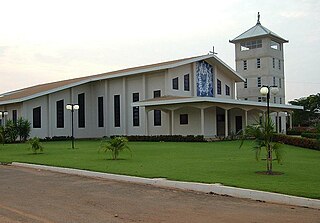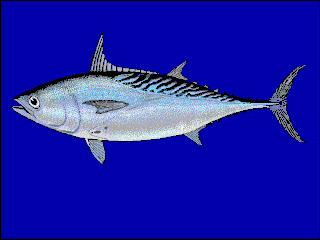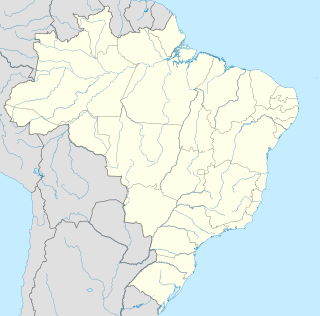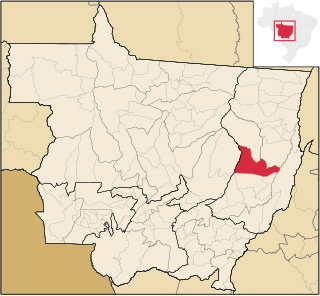
The western mosquitofish is a species of freshwater fish, also known commonly, if ambiguously, as simply mosquitofish or by its generic name, Gambusia, or by the common name gambezi. Its sister species, the eastern mosquitofish is also referred to by these names.

The little swift, is a small species of swift found in Africa and southwestern Asia, and are vagrants and local breeders in southern Europe. They are found both in urban areas and at rocky cliffs where they build nests in a way typical of all members of the order Apodiformes. The genus name Apus is Latin for a swift, thought by the ancients to be a type of swallow without feet. The Latin specific affinis means similar to or related to, but in this case the species that the little swift supposedly resembles is not clear from the description. A population formerly considered to be an eastern subspecies of little swift is now separated as a distinct species, the house swift.
The chocolate pipistrelle is a species of vesper bat in the family Vespertilionidae. It is found in China, India, Myanmar, Nepal, and Sri Lanka.

Blyth's frogmouth is a species of bird in the family Podargidae. It lives in the tropical and subtropical moist broadleaf forests of Brunei, Cambodia, Indonesia, Laos, Malaysia, Myanmar, Thailand, and Vietnam. It is sometimes considered conspecific with the Javan and Palawan frogmouths.

The black-chested jay is a species of bird in the family Corvidae.

The intermediate horseshoe bat is a bat species of the family Rhinolophidae that is very widespread throughout much of the Indian subcontinent, southern and central China and Southeast Asia.

Querência is a Brazilian municipality of state of Mato Grosso.It is located in the northeast of the state, in the Great Amazon Basin. Within its great limits are part of the Xingu Indigenous Reserve, and an immense virgin area, formed by the Cerrado Mato-grossense, Amazon Forest and a large transition area. It is located at latitude 12º35'49 "south and at longitude 52º11'59" west, being at an altitude of 350 meters. It has an area of 17.850,249 km2.

Euthynnus affinis, the mackerel tuna, little tuna, kawakawa, or tongkol is a species of ray-finned bony fish in the family Scombridae, or mackerel family. It belongs to the tribe Thunnini, better known as the tunas. This is an Indo-Pacific species which is found from the Red Sea to French Polynesia.

Canarana is a municipality in the state of Bahia in the North-East region of Brazil.

The southern river terrapin is a turtle of the family Geoemydidae found in Malaysia, Indonesia and Cambodia.

"Crocodylus" affinis is an extinct species of crocodyloid from the Eocene of Wyoming. Fossils were first described from the Bridger Formation by American paleontologist Othniel Charles Marsh in 1871. Marsh described the species, along with every other species of crocodyloid in the Bridger Formation, under the genus Crocodylus. The known specimen of "Crocodylus" affinis is a skull found at Grizzly Buttes, Wyoming, measuring 13 inches in length on the upper surface. Recent phylogenetic studies of crocodyloids show that "C." affinis is not a species of Crocodylus, but a genus has not yet been erected to include the species. Other Bridger species such as Crocodylus clavis and Brachyuranochampsa zangerli have been synonymized with "C." affinis.

Canarana is a municipality in the Brazilian state of Mato Grosso.

Bombus affinis, commonly known as the rusty patched bumble bee, is a species of bumblebee endemic to North America. Its historical range in North America has been throughout the east and upper Midwest of the United States, north to Ontario, Canada, where it is considered a "species at risk", east to Quebec, south to Georgia, and west to the Dakotas. Its numbers have declined in 87% of its historical habitat range. On January 10, 2017, the United States Fish and Wildlife Service placed B. affinis on the list of endangered species, making the rusty patched bumblebee the first bee to be added to the list in the continental United States.

Hemilophini is a tribe of longhorn beetles of the subfamily Lamiinae.
Canarana is a genus of longhorn beetles of the subfamily Lamiinae, containing the following species:
Canarana arguta is a species of beetle in the family Cerambycidae. It was described by Martins and Galileo in 2008. It is known from Brazil.
Canarana brachialis is a species of beetle in the family Cerambycidae. It was described by Félix Édouard Guérin-Méneville in 1855. It is known from Bolivia, Brazil, Peru and Ecuador.
Canarana nigripennis is a species of beetle in the family Cerambycidae. It was described by Henry Walter Bates in 1866. It is known from Brazil.
Canarana roseicollis is a species of beetle in the family Cerambycidae. It was described by Galileo and Martins in 2004. It is known from Bolivia.
Canarana seminigra is a species of beetle in the family Cerambycidae. It was described by Henry Walter Bates in 1866. It is known from Brazil.












